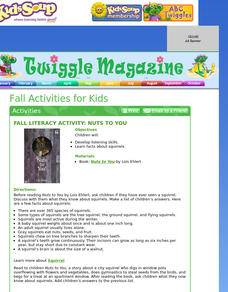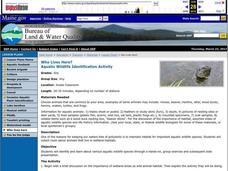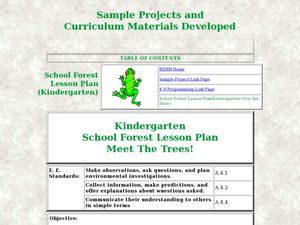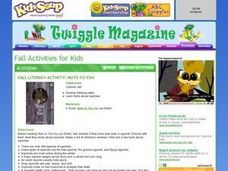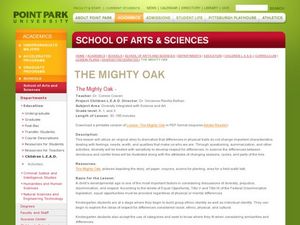Curated OER
Mighty Oaks from Little Acorns
What does it mean to grow? To germinate? For the plan detailed here, class members investigate the growth process of an oak tree while focusing on the beginning stages of planting and germination. They plant seeds and record observations...
Curated OER
Acorns
Students experience hoarding food for winter. In this squirrel lesson, students simulate hoarding behavior as either a red or gray squirrel. Students play a game called Winter Survival and discover how squirrels survive through the...
Curated OER
Nuts About Squirrels
Early childhood students will develop listening skills as they read "Nuts To You" by Lois Ehlert. In this lesson students will learn about Students will learn facts about different types of squirrels and their behaviors. There will be a...
Curated OER
Great Oaks From Little Acorns Grow
Students assemble an acorn craft to use as a puppet. They discover that acorns are the fruit and the seed from which oak trees grow. They give an example, of a historical figure or talk about a member of the community or family that...
Curated OER
Alphabet Letter a Or N Theme
Students draw a tree with acorns. They depict roots and an acorn in the soil to review plant growth and practice handwriting letter A or letter N in the writing lines. They cut an additional page for the mini-book to include the word...
Curated OER
Fall Lesson Plans
Students participate in various fall activities. In this fall activity, students take a trip to a farmers market and purchase the ingredients needed for vegetable soup. Students paint fall scenes and create a fall story. Students discuss...
PreKinders
Parts of a Tree
Don't bark up the wrong tree with this set of cards! Seven cards present different parts of a tree, including a trunk, branches, and leaves. A great addition to your science or language arts lesson.
Curated OER
Autumn Season
Students explore a nut theme for the autumn season. They assemble one acorn craft and use as a puppet for the introduction and presentation of the theme. They plan for a classroom bulletin board idea that incorporates the acorn craft.
Curated OER
Nature Art
In this nature art lesson, students take a nature walk and collect items with different sizes, textures and colors. Students use the items they collect to make a collage.
Curated OER
Who Lives Here?
Students identify various aquatic wildlife species. In this biology lesson students collect clues about animals that live in wetland habitats. Students rotate through several stations displaying particular animal species to collect their...
Curated OER
Seed Swapping
Here is a fabulous, cross-curicular lesson on seeds. Elements of science, writing, math, agricultural practices, and art are all brought into this incredibly thorough plan. Additionally, a fun whole-class game is presented, and there is...
Curated OER
Growing Learners: A Multi-Disciplinary Approach to Investigating Plants and Flowers
Engage young scientists in these inquiry-based lesson ideas to spring into learning about nature.
Curated OER
Food Chain/Food Web
Students explore ecosystems. In this ecology lesson, students read an article explaining ecosystems. Students create a visual organizer with index cards using components of various ecosystems.
Curated OER
Where Are The Dinosaurs?
Students examine the concept of extinction in relationship to the dinosaurs. In this elementary science lesson students become familiar with dinosaurs and that they are extinct. Students differentiate between different types of dinosaurs.
Curated OER
Meet the Trees!
Students investigate their school forest and make their own miniature forest. In this forest investigation lesson, students read The Giving Tree by Shel Silverstein and make alist of reasons to have trees. Students investigate trees by...
College Board
AP Physics 1 and 2 Inquiry-Based Lab Investigations
Have you ever wondered what type of AP Physics investigations The College Board wants? This is the guide for you! Sixteen labs covering both Physics I and II will get you started and inspire you to meet the requirement of 25 percent of...
Curated OER
Traveling Seeds
Students decorate their bags with crayons. In this art and science lesson, students go outside and collect seeds. Students come back inside and sort the seeds into flyers, riders, poppers, or floaters. Students discuss the differences...
Curated OER
Fall Literacy Activity: Nuts to you
Students actively listen to the book Nuts To You and learn facts about squirrels. In this squirrels lesson, students listen to the book, and discuss what they learned after.
Curated OER
Salt is Good On Sunflower Seeds, But What About Cypress?
Young scholars record their observations about growing a cypress plant and putting salt in the plant. In this cypress plant lesson plan, students observe and record what is happening as the cypress plant grows. This gives directions for...
Rainforest Alliance
My Forest or the Rainforest?
The differences between tropical and temperate rainforests range from animals and flowers to climate and landscapes. Kindergarteners compare and contrast characteristics of their local forest to a tropical rainforest.
North American Montessori Center
Sun and Moon Autumnal Equinox Activities
Two hands-on activities celebrate the sun and moon autumnal equinox. First, scholars create a cairn using a shoebox, flashlight, and drawing tools to view the sun's progression. Second, learners take to the kitchen to bake mooncakes...
Curated OER
The Touch N Feel Box
Learners discover the characteristics of living and non living objects without the use of sight. In this sense of touch lesson, students touch items put in a shoe box and must identify whether the item was once living or not by...
Curated OER
The Mighty Oak
Students investigate types of trees. In this forestry lesson, students read the book The Mighty Oak and act out the story with a partner. Students discuss the types of trees in the book and plant an oak tree on school grounds.
Curated OER
Colors of Wildlife
Students observe wildlife animals. In this wildlife lesson plan, students cut out three different animals from a wildlife magazine. Then they compare the animals, verbally stating their similarities and differences.


